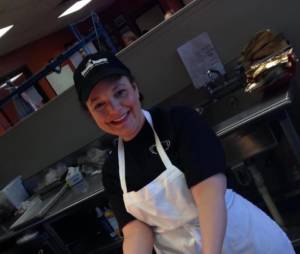
Here’s Jennifer Vigran helping with a Culinary Job Training line cooking exercise during her time as CEO.
My first volunteer shift at Second Helpings was in a small former cafeteria and dining room at the old RCA plant on LaSalle Street. With a handful of staff, 2 vehicles and 16 volunteers, we prepared and distributed almost 900 meals that day. Many of the people I met then are still engaged as volunteers, donors, and working with partner agencies around our community. We were in awe of the bounty that came from our food donors and worked each day to figure out how to prepare that food to nourish body and soul for those who were hungry throughout our community.
As the organization’s networks and reputation grew, so did our awareness of opportunities to help other not-for-profit organizations to make a meaningful impact in addressing food insecurity among their clients. When Second Helpings became a United Way agency, it opened more relationships and opportunities within a network of not-for-profit agencies that spent program funds to buy food or were frustrated in their inability to do so.
While Second Helpings was well-connected in its partner agency networks, the community-wide hunger relief system was still siloed with little communication among hunger relief organizations. That started to change in 2009 with what would eventually become the Indy Hunger Network. Together, Second Helpings, Gleaners, Midwest Food Bank, and others began mapping out the hunger relief system and asking bigger questions about building up infrastructure to get fresh, healthy food to households that too often went without, increasing access to federal food assistance programs, and researching unmet needs in our community.
But for the work Second Helpings had done to expand its networks and to build trust and collaboration with our fellow hunger relief organizations, we would not have been prepared to scale our response to the unprecedented needs we encountered during the pandemic. Beginning in March 2020, Second Helpings added a home delivery program and 67 new partner organizations, to reach households that were struggling to access nutritious food for their families. With new ways of distributing healthy meals and delivering top-notch instruction to our Culinary Job Training students, our staff never waivered in their commitment to the mission and our community.
When we emerge from this pandemic, Second Helpings and our hunger relief partners will be stronger for the meaningful private/public partnerships and lines of communication that have formed, for the rapid innovation and responsiveness that we developed amidst new challenges, and the critical eye by which we have learned to judge the equity of our decisions and their impacts.
And so, 20 years after that first volunteer shift, I look forward to watching and supporting the work of Second Helpings’ staff and volunteers from the sidelines. The rewards of my job have been many – the knowledge each day that we were supporting the work of our partner agencies in addressing homelessness, addiction, education, domestic violence, and opportunity; witnessing the extraordinary impact that volunteer service has both on those who volunteer and those who are served; marveling at the generosity of a community that comes together in times of need; celebrating the resilience and success of our culinary job training students; the support of genuine and collaborative colleagues; and working alongside an unparalleled creative and dedicated staff. For all this and so much more, I remain truly grateful.
